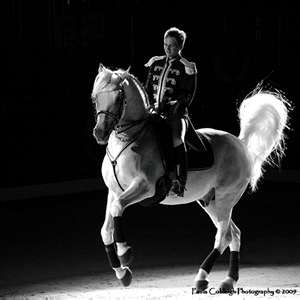日志
Lipizzaner description
||
Lipizzaner description
The Lipizzaner's name was derived from the location in which it was first bred in 1580, the Imperial Stud at Lipizza, near Trieste. The Lipizzaner is the horse of preference for the famous Spanish Riding School of Austria. Only superlative stallions which are light gray to white in color are considered for training, which they begin at the age of five. Those stallions which demonstrate excellence at the school are eventually retired to stud at Piber, the government farm were modern Lipizzaners are bred. Those individuals not suitable for the school often become excellent hunters, three-day-event horses or driving horses. The Lipizzaner's ancestors include the Arabian, Neapolitan, Barb, Andalusian and Kladruber.
It has a relatively large head with small ears, dark, expressive eyes and often a convex nose which is reminiscent of its Spanish ancestry. The body is compact with smooth musculature and substantial shoulder. The legs are short and clean, with small, hard hooves. Longevity is a common characteristic since the breed matures late. Noted for his sturdy body and proud carriage, the Lipizzan’ head is remarkable for its large appealing eyes and small alert ears. The body presents a picture of strength with a crested neck, powerful shoulders, muscular hind quarters, and strong legs with well-defined tendons and joints
Lipizzaner color
Lipizzans are genetically a type of grey. Born dark, black-brown, brown, or mouse-grey, Lipizzans gradually lighten until the white coat for which they are noted is produced somewhere between the ages of 6 and 10. The white hair coat has become dominant in the breed, and only now and then is a black or brown adult produced. As late as two hundred years ago, black, browns, chestnuts, duns, piebalds, and skewbalds were found in the adult herd.
Lipizzaner size
The Lipizzaner is not a very large horse, averaging between 14.2 and 15.2 hands, although occasionally reaching 16 hands.
Lipizzaner weight
The Lipizzaner weighs from 1,000 to 1,300 pounds
Lipizzaner temperament
The Lipizzan has a natural ability for concentration, with a great disposition for collected High School work and/or great endurance for riding and driving. Movements The Lipizzan has a proud and elevated action, and is long, elegant and in complete balance in walk, trot, and canter. The Lipizzaner temperament and character is noble, generous, and ardent, but always gentle, friendly, willing to work, able to bear pressure, and directed towards people.
Lipizzaner life expectancy
The Lipizzaner horse breed lives from 30 to 35 years
Lipizzaner origin
The Hapsburg family controlled both Spain and Austria when the art of classical riding revived in Europe during the Renaissance. There was a need for light, fast horses for use in the military and the riding school. The Spanish horse, produced during Moorish rule by crossing Berber and Arab stallions with Iberian mares, was considered the most suitable mount because of its exceptional sturdiness, beauty, and intelligence. In 1562, Maximillian II brought the Spanish horse to Austria and founded the court stud at Kladrub. His brother Archduke Charles established a similar private imperial studfarm with Spanish stock in 1580 at Lippiza (nowadays: Lipizza [Italian], or Lipica [Slovenian]) near the Adriatic Sea. Here on the Karst plateau near Triest the type of horse which was bred in Lippiza was called the Lippizaner. Today in Europe the breed is called Lipizzaner or, in America, Lipizzan.
Lipizzaner history
The ancestors of the Lipizzaner can be traced to approximately A.D. 800. The earliest predecessors of the Lipizzaner originated in the 7th century when Barb horses were brought into Spain by the Moors and crossed on native Spanish stock. The result was the Andalusian horse and other Iberian horse breeds.
By the 16th century, when the Habsburgs ruled both Spain and Austria, a powerful but agile horse was desired for both military uses and for use in the fashionable and rapidly-growing riding schools for the nobility of central Europe. Therefore, in 1562, the Habsburg Emperor Maximillian II brought the Spanish Andalusian horse to Austria and founded the court stud at Kladrub. In 1580, his brother, Archduke Charles II, established a similar stud at Lipizza (now Lipica), located in modern-day Slovenia, from which the breed obtained its name.
Kladrub and Lipizza stock were bred to the native Karst (Kras) horses, and succeeding generations were crossed with the now-extinct Italian horse breed Neapolitan and other Baroque horses of Spanish descent obtained from Spain, Germany, Denmark. While breeding stock was exchanged between the two studs, Kladrub specialized in producing heavy carriage horses, while riding and light carriage horses came from the Lipizza stud.
Beginning in 1920, the Piber stud, near Graz, Austria, became the main stud for the horses used in Vienna. Breeding became very selective, only allowing stallions that had proved themselves at the Riding School to stand at stud, and only breeding mares who had passed rigorous performance testing.
Lipizzaner genetic diseases
Inbreeding can cause melanoma
Lipizzaner uses
Although, historically, the Lipizzaner is a carriage horse, and a dressage horse breed, especially famous for the 'Airs above the Ground' as performed at the Spanish Riding School in Vienna - it is also used in many countries for trial driving, endurance (long distance) riding,showjumping and a few are in circuses.
Lipizzaner influence
Arabian, Barb, Andalusian, Neapolitan, Kladruber, Fredericksborg
Lipizzaner interesting facts
Lipizzans have starred or played supporting roles in many movies, TV shows and books. The World War II rescue of the Lipizzan stallions is depicted in the 1963 Walt Disney movie Miracle of the White Stallions. In the film Crimson Tide, a discussion between the two protagonists over whether Lipizzans came from Spain or Portugal is used to represent the film's suppressed racial conflict and the dividing of the world between the two main powers during the Cold War.
Because of the status of Lipizzans as the only breed of horse developed in Slovenia, via the Lipica stud, Lipizzans are recognized in Slovenia as a national symbol. For example, a pair of Lipizzans is featured on the 20-cent Slovenian euro coins.



